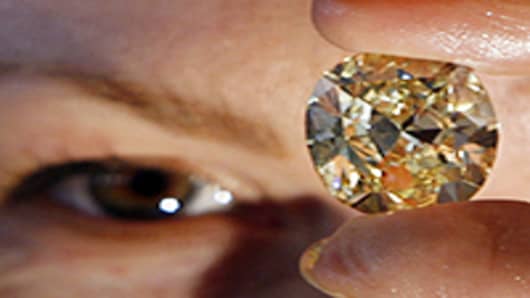Indians have long been the world’s biggest buyers of gold — so much so that changes in their consumption tip the scales of global demand. Recently, those scales have tipped down.
This year, China surpassed India in overall gold demand, according to the World Gold Council, largely because by the end of the second quarter, gold jewelry demand in India had dropped 30 percent year-over-year.
Why? Because wealthy Indians have discovered diamonds.
“India has become the fastest-growing market for de Beers. It’s now a priority market for us,” said Forevermark CEO Stephen Lussier. Forevermark is a subsidiary of the De Beers Group, the largest supplier of diamonds in the world.
“It’s also the most extravagant market in terms of its diamond designs. Women wear such extraordinary pieces. You wouldn’t see that in Europe unless you were having dinner with the Queen,” he added. (More:A Fast Food Nation Turns Health Conscious)
India’s ‘diamond discovery,’ isn’t just about the bling. It is being driven by price moves and currency devaluation. Persistently high gold pricesover the past year have been coupled with a depreciation of the rupee against the dollar. In fact, the rupee
has lost 25 percent of its value against the dollar over the same period. This exacerbated the price of gold for Indians, because gold is priced in dollars.
At the same time, diamonds became cheaper. By the end of the second quarter of this year, the average asking price for 1-carat diamonds dropped about 18 percent year-over-year, according to the Rapaport Diamond Trade Index. In dollar terms, diamond dealers can now purchase a 1-carat diamond for about $8,384, down from $9,175 last year, according to Rapaport’s index.
Yet varying cuts and qualities make the value of all diamonds difficult to assess. Diamond exchanges do not have official rates, and unlike gold, are not quoted on a daily basis.
In this case, then, transactions speak louder than quotes.
Marketers Shine to Indian Brides
Gold bullion’sprice moves aren’t the only factor in India’s new affinity for diamonds. In the past few years, diamond marketing campaigns have targeted India’s wedding market—which has opened its bejeweled arms. (More:A Gluttonous Food Industry That Lacks Investors)
“Before De Beers started marketing in India, the market was entirely gold focused. Now De Beers spends $4 to $5 million per year on consumer marketing in India,” said Forevermark CEO Lussier. Over the last five years, Lussier adds that DeBeers’ marketing investment has been rewarded with over 20 to 30 percent sales growth “year in and year out.”
Worldwide retailers are gunning to gain share before the diamond jewelry market becomes as crowded as Indian cities themselves. Their main competitor is Indian diamond jeweler Tanishq, already known to dominate the largest cities, Mumbai and Delhi. Indians say Tanishq's popularity is due to its modern designs, coveted by India’s younger generation.
“When I look at my mom’s wedding jewelry, is it mostly gold. Indian wedding jewelry has become much more modern, and more diamonds are used,” said Indian newlywed, Saniya Ghandi Bhardwaj.
In affluent families, the mother and father of the bride give custom-made jewelry sets as a ceremonial gift to their daughter. The importance of this gift, Bhardwaj explained, is essentially based in traditional Hindu theology, which holds that the bride is being sent to the groom’s family. Depending on the family wealth, traditional gifts can consist of gold only, but the trend among the affluent has turned to diamonds.
“On Sangeet night [a traditionally lavish celebration on the eve of an Indian wedding], 1,200 guests attended and throughout the night, I wore the diamond sets my parents gave me,” she added.
While wealthy Indian families embrace the diamonds trend, some investors are getting nervous, wondering whether gold demand will continue to drop.
Should gold investors worry?
“We don’t believe it’s over for gold over there,” said David Darst, Chief Investment Strategist of Morgan Stanley Smith Barney . “Sure, Indian buyers have backed away because of the high prices, but they won’t abandon it. They’re waiting for the rupee to climb or gold to fall.”
While gold demand for Indian weddings has tapered off, so too has it dropped in the jewelry and investment sectors. At 56.5 tons, Indian investment demand was less than half its level in the second quarter of 2011, according to the World Gold Council.
Darst contends that this drop reflects somewhat predictable behavior from investors treating the precious metal as a pure commodity play.
“When gold [prices] go up, usually India is a seller and Western Europe is a buyer. When gold goes down, India is a buyer. They get it right over there, and we get it wrong here,” added Darst. (More:10 Hot Indian Startups)
To this logic, gold demand may have bottomed in India, and may rebound. The question is, to what degree?
Slowing GDP growth, which dropped from 8 percent to 5.5 percent in the last year, suggests a rebound is still far off.
“We are expecting India's GDP growth to gradually rise to 5.8 percent during the year ending March 2013 and further to 6.6 percent the year after that. The marginal uptick in growth is due to more accommodative monetary conditions,” said Sonal Varma, India economist at Nomura .
That said, the economic impact on gold and diamond markets is not exactly equal. While middle class Indians cut back on gold jewelry spending, the country’s wealthiest are still buying what they want, and weddings are simply the most prominent expression of that.
“Almost regardless of what’s happening in the economy, if there’s a wedding, they pull out all the stops. They save from the day the girl is born, and jewelry doesn’t seem to be compromised,” said Lussier.
The difference is that now, like never before, ‘pulling out all the stops’ means more diamonds.



